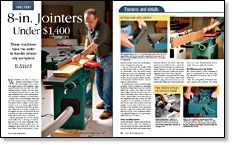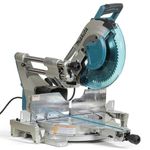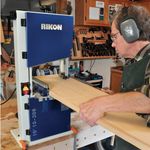8-in. Jointers Under $1,400
These machines have the width to handle almost any workpiece
Synopsis: Anyone shopping for an 8-in. jointer has plenty of options. Contributing editor William Duckworth tested 11 machines ranging in price from $650 to $1,350, putting each through a series of inspections and tests to find out of there are substantial differences.
Machines reviewed include the Bridgewood BW8J, Craftsman 2170300, Delta/37-380, Delta 37-350A, General 80-200, Grizzly G0500, Jet JJ-8CS, Powermatic 60B, Sunhill CT-204L, Woodtek 907064, and Yorkcraft YC-8J.
Whether you buy it rough or dressed, solid lumber is rarely flat and straight, and a jointer will flatten surfaces and straighten edges more efficiently than any other tool. After visiting dozens of shops over the years, I’m convinced that the jointer is one of the least understood and most underappreciated machines available to woodworkers.
People new to woodworking often ask me what machines they should purchase and, given limited budgets, in what order. A jointer is No. 2 on my list, right behind a tablesaw. The answer to the follow-up question, “What size do I need?” is simple: Get the biggest one you can afford and fit into your shop. For many woodworkers, an 8-in. jointer fits best into those constraints.
Anyone shopping for an 8-in. jointer won’t suffer from a shortage of choices. My search for the most commonly available machines quickly added up to 11, ranging in price from $650 to $1,350. All have either 11⁄2-hp or 2-hp motors. To compare the jointers, I put each one through a series of inspections and tests.
I was not able to get the Grizzly G0586 in time for this review. It will be reviewed in a future issue. Also, this review doesn’t include the pricier 8-in. machines on the market: The Delta 37-365X ($1,670), General 480-1 ($2,230), Grizzly G9859Z ($2,500), or Powermatic 1610079 ($1,570). Look for them in a future review.
As machines go, jointers are fairly simple in design. The bed consists of a cutterhead flanked by independent infeed and outfeed tables and a fence. The tables are basically wedges that ride up and down on a track of dovetailed ways. The bed rests on a base, which holds a motor that powers the cutterhead with one or more fan belts on pulleys. For the machine to work properly, the two table surfaces must be flat and parallel to each other, both front to back (parallel to the centerline of the cutterhead) and left to right. The outfeed table is flush with the top arc of the cutterhead knives. You adjust the depth of cut by moving the infeed table up and down.
Some assembly required
All the machines require some work before they can be used. You will have to bolt the bed to the base, adjust the motor mount, install the belts, and in many cases, wire the switch to the motor. After that, you’ll need to install the fence. Given the weight involved, putting one of these machines together is a task that will require more than one person, unless your shop is equipped with a heavy-duty chain lift.
Some machines come prewired with a plug for either 110v or 220v circuits.
From Fine Woodworking #180
For the full article, download the PDF below:
Fine Woodworking Recommended Products

Makita LS1219L Miter Saw

Rockler Dust Right 650 CFM

Rikon 10-3061 10-in. Deluxe Bandsaw
The saw has two speeds: 3,280 sfpm (surface feet per minute) for wood and 1,515 sfpm for soft metals and some plastics.





















Log in or create an account to post a comment.
Sign up Log in